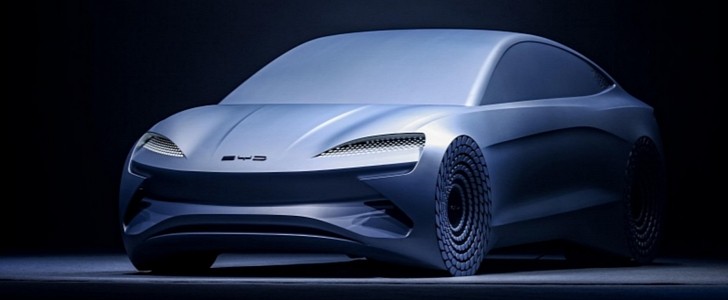It seems BYD will christen all its vehicles connected with the e-platform 3.0 with names related to the sea. While the first one was called Dolphin, the company presented the design study of its flagship over the same architecture. It is called ocean-X, but the final name may change for the production version of the electric sedan.
BYD is undoubtedly making a slow introduction to its future flagship on the e-platform 3.0. It said the car would go from 0 to 100 kph (62 mph) in precisely 2.9 seconds. A working prototype must have proved the company could claim that without risks of failing to deliver such figure – and all the others.
The Chinese automaker also said the ocean-X could exceed 1,000 kilometers (621 miles) on a full charge, but it did not disclose under which test cycle that would be the case: WLTP or NEDC. Its 800V system would allow the electric sedan to recover 150 km (93.2 mi) in 5 minutes. Unfortunately, BYD did not disclose at which charging speed: it must be at least 270 kW.
According to the company, the ocean-X is a mid-size sports car, something that can be completely different from what a mid-size vehicle is in the U.S. China tends to follow the European classification, meaning the ocean-X would belong to the C-segment, which corresponds to compact cars in the American market. That would make the future sports car smaller than the BYD Han.
More than the ocean-X, BYD is proud of its Blade Battery and the e-platform 3.0. It would have a heat pump system that would make its cars operate from -30ºC (-17ºF) up to 60ºC (140ºF) temperatures. The direct cooling and heating for the battery pack would make cars based on this architecture 20% more thermally efficient. That means they would have a 20% higher range in the winter, something that Norwegian customers may really enjoy.
With a drag coefficient of 0.21, the ocean-X would be so efficient that its AWD system would demand as much energy as an EV with a single motor. Again, those are pretty substantial claims that the company would not make based solely on a design study. Expect to see a proper concept in the next few months and the production version of this EV soon after that: it is more ready than BYD would care to disclose at this point.
The Chinese automaker also said the ocean-X could exceed 1,000 kilometers (621 miles) on a full charge, but it did not disclose under which test cycle that would be the case: WLTP or NEDC. Its 800V system would allow the electric sedan to recover 150 km (93.2 mi) in 5 minutes. Unfortunately, BYD did not disclose at which charging speed: it must be at least 270 kW.
According to the company, the ocean-X is a mid-size sports car, something that can be completely different from what a mid-size vehicle is in the U.S. China tends to follow the European classification, meaning the ocean-X would belong to the C-segment, which corresponds to compact cars in the American market. That would make the future sports car smaller than the BYD Han.
More than the ocean-X, BYD is proud of its Blade Battery and the e-platform 3.0. It would have a heat pump system that would make its cars operate from -30ºC (-17ºF) up to 60ºC (140ºF) temperatures. The direct cooling and heating for the battery pack would make cars based on this architecture 20% more thermally efficient. That means they would have a 20% higher range in the winter, something that Norwegian customers may really enjoy.
With a drag coefficient of 0.21, the ocean-X would be so efficient that its AWD system would demand as much energy as an EV with a single motor. Again, those are pretty substantial claims that the company would not make based solely on a design study. Expect to see a proper concept in the next few months and the production version of this EV soon after that: it is more ready than BYD would care to disclose at this point.
?????????ocean-X pic.twitter.com/f3NDzZ39Dq
— Olala ???????????????????????? (@olalakl1) September 8, 2021







